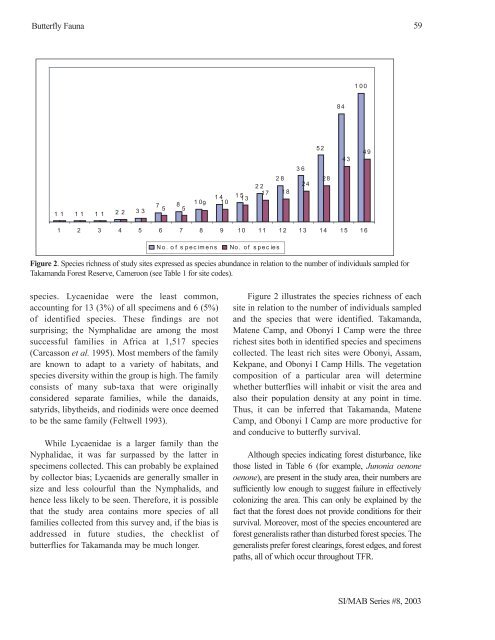Fisheries in the Southern Border Zone of Takamanda - Impact ...
Fisheries in the Southern Border Zone of Takamanda - Impact ...
Fisheries in the Southern Border Zone of Takamanda - Impact ...
You also want an ePaper? Increase the reach of your titles
YUMPU automatically turns print PDFs into web optimized ePapers that Google loves.
Butterfly Fauna<br />
7 8 109<br />
1 1 1 1 1 1 2 2 3 3 5 5<br />
species. Lycaenidae were <strong>the</strong> least common,<br />
account<strong>in</strong>g for 13 (3%) <strong>of</strong> all specimens and 6 (5%)<br />
<strong>of</strong> identified species. These f<strong>in</strong>d<strong>in</strong>gs are not<br />
surpris<strong>in</strong>g; <strong>the</strong> Nymphalidae are among <strong>the</strong> most<br />
successful families <strong>in</strong> Africa at 1,517 species<br />
(Carcasson et al. 1995). Most members <strong>of</strong> <strong>the</strong> family<br />
are known to adapt to a variety <strong>of</strong> habitats, and<br />
species diversity with<strong>in</strong> <strong>the</strong> group is high. The family<br />
consists <strong>of</strong> many sub-taxa that were orig<strong>in</strong>ally<br />
considered separate families, while <strong>the</strong> danaids,<br />
satyrids, liby<strong>the</strong>ids, and riod<strong>in</strong>ids were once deemed<br />
to be <strong>the</strong> same family (Feltwell 1993).<br />
While Lycaenidae is a larger family than <strong>the</strong><br />
Nyphalidae, it was far surpassed by <strong>the</strong> latter <strong>in</strong><br />
specimens collected. This can probably be expla<strong>in</strong>ed<br />
by collector bias; Lycaenids are generally smaller <strong>in</strong><br />
size and less colourful than <strong>the</strong> Nymphalids, and<br />
hence less likely to be seen. Therefore, it is possible<br />
that <strong>the</strong> study area conta<strong>in</strong>s more species <strong>of</strong> all<br />
families collected from this survey and, if <strong>the</strong> bias is<br />
addressed <strong>in</strong> future studies, <strong>the</strong> checklist <strong>of</strong><br />
butterflies for <strong>Takamanda</strong> may be much longer.<br />
14<br />
10<br />
15<br />
13<br />
22<br />
17<br />
1 2 3 4 5 6 7 8 9 10 11 12 13 14 15 16<br />
No. <strong>of</strong> s pecimens No. <strong>of</strong> spec ies<br />
Figure 2. Species richness <strong>of</strong> study sites expressed as species abundance <strong>in</strong> relation to <strong>the</strong> number <strong>of</strong> <strong>in</strong>dividuals sampled for<br />
<strong>Takamanda</strong> Forest Reserve, Cameroon (see Table 1 for site codes).<br />
28<br />
18<br />
36<br />
24<br />
52<br />
28<br />
Figure 2 illustrates <strong>the</strong> species richness <strong>of</strong> each<br />
site <strong>in</strong> relation to <strong>the</strong> number <strong>of</strong> <strong>in</strong>dividuals sampled<br />
and <strong>the</strong> species that were identified. <strong>Takamanda</strong>,<br />
Matene Camp, and Obonyi I Camp were <strong>the</strong> three<br />
richest sites both <strong>in</strong> identified species and specimens<br />
collected. The least rich sites were Obonyi, Assam,<br />
Kekpane, and Obonyi I Camp Hills. The vegetation<br />
composition <strong>of</strong> a particular area will determ<strong>in</strong>e<br />
whe<strong>the</strong>r butterflies will <strong>in</strong>habit or visit <strong>the</strong> area and<br />
also <strong>the</strong>ir population density at any po<strong>in</strong>t <strong>in</strong> time.<br />
Thus, it can be <strong>in</strong>ferred that <strong>Takamanda</strong>, Matene<br />
Camp, and Obonyi I Camp are more productive for<br />
and conducive to butterfly survival.<br />
Although species <strong>in</strong>dicat<strong>in</strong>g forest disturbance, like<br />
those listed <strong>in</strong> Table 6 (for example, Junonia oenone<br />
oenone), are present <strong>in</strong> <strong>the</strong> study area, <strong>the</strong>ir numbers are<br />
sufficiently low enough to suggest failure <strong>in</strong> effectively<br />
coloniz<strong>in</strong>g <strong>the</strong> area. This can only be expla<strong>in</strong>ed by <strong>the</strong><br />
fact that <strong>the</strong> forest does not provide conditions for <strong>the</strong>ir<br />
survival. Moreover, most <strong>of</strong> <strong>the</strong> species encountered are<br />
forest generalists ra<strong>the</strong>r than disturbed forest species. The<br />
generalists prefer forest clear<strong>in</strong>gs, forest edges, and forest<br />
paths, all <strong>of</strong> which occur throughout TFR.<br />
84<br />
43<br />
100<br />
49<br />
59<br />
SI/MAB Series #8, 2003

















